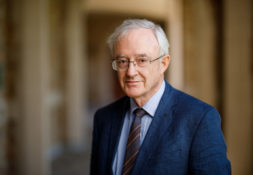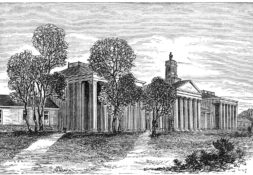The Theology and Science Surrounding Humanae Vitae
This summer, the Church will celebrate on July 25, the Feast of St. James, the first of the apostles to be martyred. The first reading for Mass that day proclaims that in preaching the Gospel of Christ, “[w]e hold this treasure in earthen vessels that the surpassing power may be of God and not from us” and “so that the life of Jesus may be manifested in our mortal flesh” (2 Cor 4:7, 11). St. Paul emphasizes our bodily nature. We are physical creatures formed of the dust of the earth, yet we have received the breath of life through God’s insufflation (Gen 2:7). We are humble earth creatures with our feet on the humus from which we came, but we stand upright gazing into the depths of the universe, our bipedal carriage a reflection of our transcendent spirit capable of relationship with God. Our Christian bodies are a thesaurus, an earthen treasure chest that manifests the very life of the Risen Jesus.
This upcoming July 25 also marks the 50th anniversary of Pope Paul VI’s encyclical Humanae Vitae (HV) that, in reaffirming the Catholic Church’s two millennia teaching on the dignity of conjugal love and opposition to artificial birth control, proclaims the truth of our being earthen vessels that indeed have a precious treasure to enrich and fulfill spousal love and communion. HV raises the fundamental anthropological question about our bodily identity as creatures and to what extent we may exercise technological control over these earthen vessels that we are. Is there a way of being human that demands we limit our power and refrain from interfering with our bodily givenness?
Pope Francis, in considering the gift of the natural world from the Creator, recognized a condition for legitimate interventions by humans into the natural ecology and ecosystems of the biosphere, namely, respecting the “‘grammar’ inscribed in nature.” Applying this to us, “Is there a grammar to being human?” Pope John Paul II affirmed this in Centesimus annus: “Not only has God given the earth to man, who must use it with respect for the original good purpose for which it was given to him, but man too is God’s gift to man. He must therefore respect the natural and moral structure with which he has been endowed” (§38). In concert with respecting the grammar of natural ecology, we are to respect the grammar of human ecology.
Let us look at the grammar of human fertility. The procreation of human life results from the sexual union of a man and a woman in which the man’s sperm fertilizes the woman’s ovum. A healthy post-puberty male is always fertile. A healthy post-puberty woman is fertile only during a limited time when she ovulates during her menstrual cycle. Though a woman’s ovum only lives for twelve to twenty-four hours, it is typically only fertilizable within the first sixteen hours. Fertility requires more than just the gametes. Sperm survival depends upon the conditions found within the woman’s reproductive tract. Part of the woman’s fertility cycle is the production of mucus from the crypts of her cervix. The woman can readily detect by external observation what type of cervical mucus is present. She can thus determine when the biological valve is open (she is fertile) and when it is closed (she is infertile). The release of progesterone from the corpus luteum following ovulation also has a thermogenic effect in raising a woman’s basal body temperature.
By charting her cycle, a woman knows when she is fertile and capable of conceiving new human life. These observations are independent of whether the woman has a regular cycle or not. Responding to Paul VI’s exhortation in HV for doctors to learn about human fertility, Thomas Hilgers, M.D. took up this call and developed the Creighton Model FertilityCare System. Women chart their fertility cycles, recording external observations of vaginal discharge. The keystone day of the cycle is the Peak Day, which is the final day when the cervical mucus is Type E. The Peak Day is an indication of the day of ovulation. The days prior to and following the Peak Day are designated, respectively P-2, P-1, P+1, P+2, etc. Knowing the grammar of human fertility, couples can try and achieve or avoid pregnancy with great effectiveness.
From studies by Dr. Hilgers over seventeen years and 2,000 cycles of women attempting to become pregnant, the correspondence between the Peak Day as determined by cervical mucus and ovulation as detected by ultrasound was strong as seen in those cycles that resulted in pregnancy: ovulation occurred on the Peak Day in 36.2% of the cycles, 14.9% on P-1, 23.4% on P+1, and 12.7% on P+2. No pregnancies over these seventeen years were ever observed before P-2 or after P+3. Fertility only exists during a discrete window of days. The grammar of fertility was also shown by Allen Wilcox, M.D. et al’s 1995 study in The New England Journal of Medicine of 221 women who were planning on getting pregnant. Of the 192 pregnancies that resulted over this time period, the couples involved had sex at least once during the six days that ended on the day of ovulation (DOv). Zero pregnancies resulted from sexual intercourse on days after ovulation or more than six days prior to the DOv. The probability of conception for each day was the following: DOv-5 (10%); DOv-4 (16%); DOv-3 (14%); DOv-2 (27%); DOv-1(31%); DOv (33%).
Couples who understand the grammar of the woman’s body can also use this knowledge to space births or avoid pregnancy. Of course, this requires that the couple abstain from sexual intercourse during the fertile phase. In 1993, R. E. Ryder published a study in the British Medical Journal of just under 20,000 poor women in Calcutta (sic) (52% Hindu, 27% Muslim, and 21% Christian) who were seeking to avoid pregnancy by using observations of cervical mucus. The rate of 0.2 pregnancies/100 women users yearly (Pearl Index) was better than other artificial methods: condoms (3.6), diaphragms (1.9), progestogen only oral contraception (1.2) and nearly as good as combined oestrogen-progestogen oral contraception (0.18). The probability of conception from intercourse outside the fertile period defined by cervical mucus was 0.004 (22 pregnancies out of 6,158 cycles with sexual intercourse). The user and method effectiveness of using the natural grammar of the body to know when to abstain from sex has been shown over and over again to be as effective, if not more so, than hormonal contraception.
If a couple is trying to avoid pregnancy, natural family planning is effective and respects the grammar of the natural fertility of a woman’s body. The man and woman decide together to abstain from becoming one flesh during the window of fertility that the woman can know from observing her body. Implicit in this grammar is that a human’s procreative organs are directed toward procreation, just as eyes are for seeing and the digestive system is for growth and maintenance. The grammar of ecology supports HV’s teaching that the conjugal act has “an intrinsic relationship to the procreation of human life” (§11) that should not be disrupted.
Artificial birth control disrupts this grammar. First, hormonal contraception deliberately impairs the natural healthy fertility of a woman. It affects over 130 metabolic processes in the body. The World Health Organization has classified combined oral contraceptives as “carcinogenic to humans.” Hormonal contraception also has side effects that include weight gain, nausea and vomiting, and a diabetic-like state. Uncommon but serious side effects include thromboembolism (i.e., blood clots) that can cause heart attack or stroke; cervical cancer, liver tumors, gall bladder disease, hypertension, and infertility. It has also been linked with depression. Hormonal contraception not only acts counter to our human ecology, it has negative effects upon the grammar of natural ecology. The synthetic estrogen, 17α-ethinylestradiol, of hormonal contraception is just one of a number, but the most potent by far, of numerous synthetic chemicals entering aquatic ecosystems that act as endocrine disruptors in organisms, threatening populations of fish (and other organisms) with decline or collapse by turning male fish female or intersex. For an overview of the voluminous research into this, see the work of Susan Jobling and Richard Owen.
The grammar of human ecology bespeaks a way of being earthen vessels created by God such that we flourish by respecting and living within that grammar. The temptation always before us as creatures is to deny our creatureliness and construct our own reality, our own grammar. But the natural and evangelical moral grammar is not something we, nor even the Church, can alter. “Since the Church did not make either of these laws, she cannot be their arbiter—only their guardian and interpreter. It could never be right for her to declare lawful what is in fact unlawful, since that, by its very nature, is always opposed to the true good of man” (HV 18). The fiftieth anniversary of HV is an opportunity to rediscover our creaturely identity as earthen vessels who glorify God by living in accord with our given grammar of human ecology.
Father Terry Ehrman, CSC, is the assistant director of the Center for Theology, Science, and Human Flourishing and a concurrent instructor in the Theology Department at the University of Notre Dame. He can be contacted at terhman1@nd.edu.






Leave a Reply